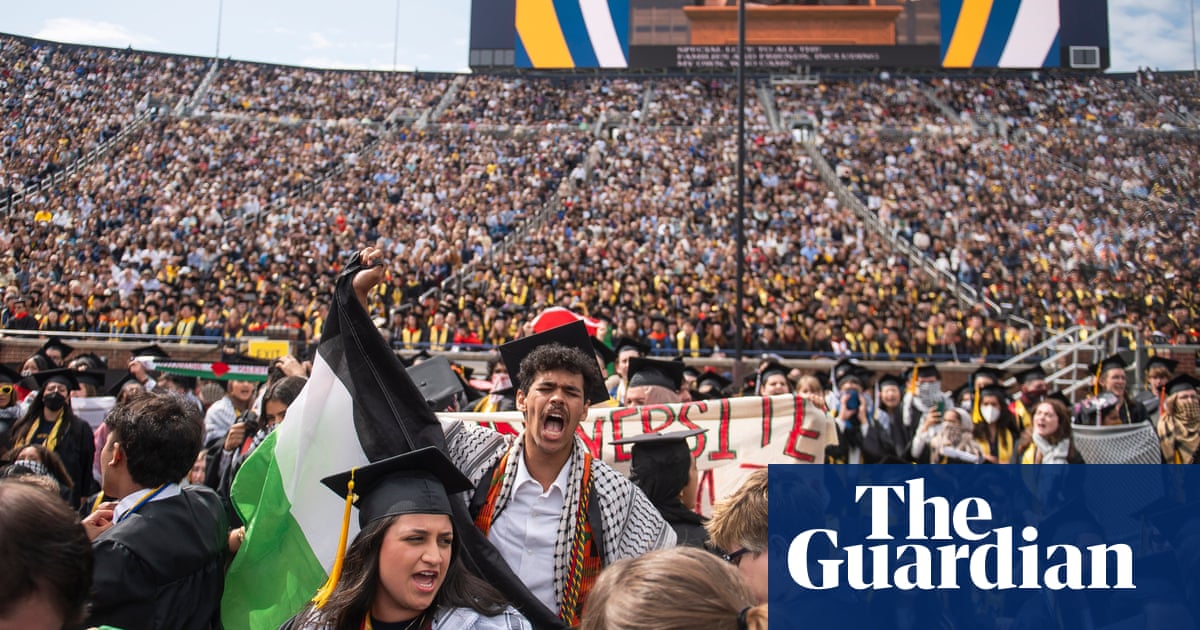
In the tented camps and crowded streets of Rafah, the pro-Palestine campus protests in the US have been followed closely.
“We hear a lot of news about students’ demonstrations in American universities … When I saw that, I was very happy that there are still those who stand beside us and in support of us,” said Nevin Abu Shahma, 39, who fled to Rafah from northern Gaza early in the war.
Pro-Palestine protests that have fanned across US universities for weeks are now more muted after a series of clashes with police, mass arrests and a stern White House directive to restore order.
But similar demonstrations have spread in some form to campuses in Britain, France, Australia and elsewhere, and on Saturday students waved Palestinian flags and chanted anti-war slogans during a ceremony at the University of Michigan.
Asmaa al-Najili, 30, who had arrived in Rafah from Khan Younis, a nearby city which was the site of heavy fighting in March, said she had used news clips of protesting students to cheer up her seven-year-old daughter.
More than a million people displaced from elsewhere in Gaza by Israel’s military offensive are sheltering in Rafah, the territory’s southernmost city. Most are kept up to date by social media – when they can get signals or charge their phones – or local radio channels broadcasting live feeds of Middle Eastern TV channels like Al Jazeera.
Haitham Abu Marsa said that before the recent unrest few in Gaza had heard of the US universities where the protests have been most intense. Like many in Rafah, he said the activism seen in the US highlighted the lack of protest in support of Palestinians in the Arab world.
“These protests [in the US] … made us happy by finding people from the west who stood with our cause … [But] at the same time it made us sad because our brothers in the Arab countries did not do what these people did,” the 33-year-old said.
The war has killed more than 34,500 Palestinians, according to Gaza’s local health officials, caused widespread destruction and plunged the territory into an unprecedented humanitarian crisis. Tens of thousands are unaccounted for.
The conflict began on 7 October when Hamas attacked southern Israel, abducting about 250 people and killing roughly 1,200, mostly civilians. Eighty hostages were released in exchange for Palestinian prisoners in Israeli jails during a short-lived truce in November. Israel said Hamas is still holding about 100 hostages and the remains of more than 30 others.
Repeated threats by Israeli officials to launch a major military operation into Rafah have made many in the city very anxious, and some have already moved on elsewhere. Israel said Hamas leaders and four battalions of militants are based there, as well as some of the hostages.
Though there is now more food available in Rafah, inadequate supplies, overcrowding and a lack of health facilities have caused a continuing acute humanitarian crisis.
The growing death toll in Gaza and images of the widespread destruction there have swayed public opinion in the US, with support for Israel’s military assault dropping from 50% in a November Gallup poll to 36% in late March. Bernie Sanders drew comparisons with protests in the US against the war in Vietnam.
In Rafah, Marwan Hegazy, from the Jabaliya refugee camp in northern Gaza, also referred to the mass demonstrations of the 1960s.
“The protests of university students were the reason for stopping other wars in the past, such as the Vietnam war,” Hegazy, 60, said. “We hope that the rest of the students of the world will stand up for us.”
Messages to the protesters were scrawled on a handful of tents in the camp, with one reading: “Thank you students in solidarity with Gaza. Your message has reached us. Thank you students of Columbia. Thank you students”.